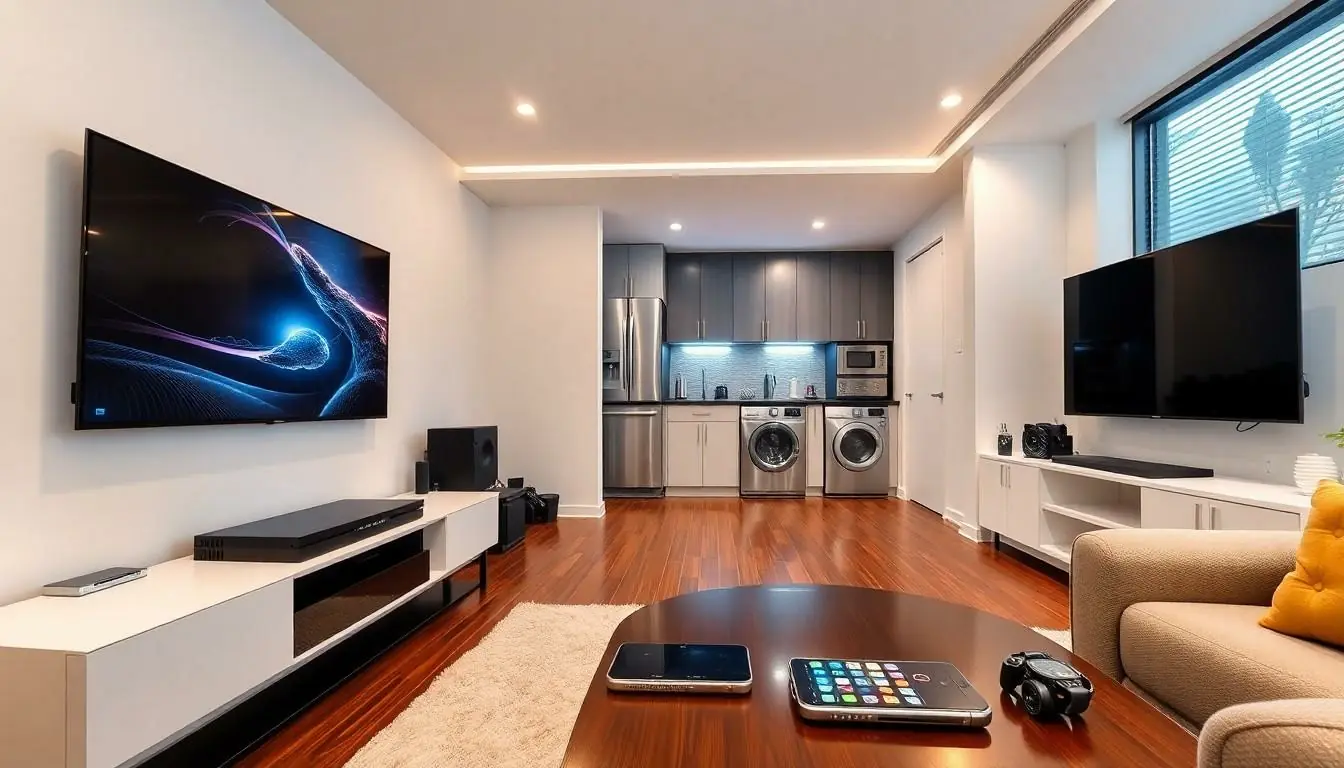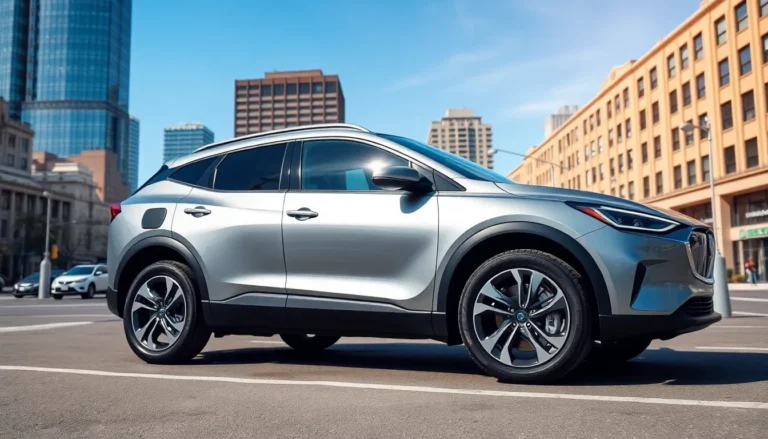In a world where gadgets reign supreme, consumer electronics have become the heartbeat of modern life. From smartphones that keep us connected to smart fridges that remind us to buy milk, these devices aren’t just luxuries—they’re essentials. Ever tried living without your trusty tablet? It’s like going back to the Stone Age, minus the cool cave paintings.
Table of Contents
ToggleWhat Is Consumer Electronics?
Consumer electronics refer to electronic devices designed for personal use. This category includes a wide range of products such as smartphones, tablets, televisions, laptops, gaming consoles, and home appliances. These devices play a crucial role in daily activities and entertainment, often impacting how individuals communicate, access information, and manage their daily tasks.
Understanding the evolution of consumer electronics reveals a shift from basic functionalities to complex, interconnected systems. Many devices now feature smart technology, enabling remote access and automation. For instance, smart thermostats optimize energy usage, while smart refrigerators can monitor food inventory, making life more convenient.
Market trends indicate a continuous demand for innovation in this sector. As of 2023, the global consumer electronics market amounts to approximately $1 trillion. Consumers increasingly prioritize features such as energy efficiency, connectivity, and user experience. Companies invest in research and development to meet these evolving consumer expectations.
In addition to improving lifestyle, consumer electronics also support sustainable practices. Many newer models emphasize eco-friendly materials and energy-saving designs. As consumers become more aware of environmental impacts, the shift towards greener technology trends strengthens.
Overall, consumer electronics serve as essential tools that enhance modern living. From facilitating communication to automating household chores, these devices seamlessly integrate into everyday life. As technology progresses, the influence of consumer electronics continues to expand, shaping the way society interacts with the world.
Types of Consumer Electronics

Consumer electronics encompass a variety of devices that improve daily life and facilitate modern living. These devices can be broadly categorized into three main types: home appliances, personal devices, and entertainment equipment.
Home Appliances
Home appliances streamline household tasks and enhance everyday functionality. Refrigerators, washing machines, and ovens represent the core of this category, integrating smart technology for improved efficiency. Many modern appliances offer Wi-Fi connectivity, allowing remote control through smartphones. Smart thermostats adjust temperatures automatically based on user habits, promoting energy savings. Industry trends show consumers increasingly favoring eco-friendly appliances, as evidenced by substantial sales of Energy Star-rated products in recent years.
Personal Devices
Personal devices play a significant role in communication and daily management. Smartphones, tablets, and smartwatches fall into this category, serving diverse functions that range from social interaction to health monitoring. Each device supports applications that enhance productivity, entertainment, and connectivity. With over 1 billion smartphone users as of 2023, these devices shape social interactions significantly. Users rely on personal devices to access information instantly, manage schedules, and track fitness goals.
Entertainment Equipment
Entertainment equipment contributes to leisure and enjoyment at home. Televisions, gaming consoles, and sound systems enhance viewing and listening experiences. Many televisions are now smart, granting access to streaming platforms and online content. Gaming consoles, like the PlayStation and Xbox, offer immersive gameplay with high-definition graphics. This segment experienced remarkable growth, with the global gaming market valued at approximately $220 billion in 2023. Consumers increasingly demand high-quality audio-visual setups to enjoy a cinema-like experience at home.
The Evolution of Consumer Electronics
Consumer electronics have undergone significant transformations over the decades, reflecting changes in technology and consumer needs. Innovations have shifted the landscape of daily life, integrating advanced functionalities into everyday devices.
Historical Overview
Market demand for consumer electronics began with simple radios and black-and-white televisions in the early 20th century. The introduction of color TVs in the 1960s marked a significant shift, influencing leisure activities. The 1980s brought about the emergence of personal computers, setting the stage for digital interaction. The 1990s saw the rise of mobile telecommunication with the debut of cell phones. By the 2000s, smartphones began to redefine connectivity, with over 1 billion users adopting this technology by 2023. Each decade revealed evolving priorities, emphasizing innovation that directly aligns with consumer lifestyles.
Technological Advancements
Technological advancements significantly impacted consumer electronics, fostering the rise of smart devices. Innovations such as the Internet of Things (IoT) have enabled devices to connect and communicate seamlessly. Smart appliances, like refrigerators that monitor inventory, now enhance efficiency in the home. Artificial intelligence integration allows for personalized user experiences, adapting devices to individual preferences. The shift towards energy efficiency drives companies to develop eco-friendly designs and materials. As of 2023, the global consumer electronics market reached approximately $1 trillion, demonstrating the continual pursuit of cutting-edge technology that resonates with modern consumers.
The Impact of Consumer Electronics on Daily Life
Consumer electronics transform daily experiences through enhanced connectivity and convenience. Devices like smartphones integrate seamlessly into lives, facilitating instant communication and access to information.
Connectivity and Communication
Smartphones, tablets, and laptops enhance connectivity among individuals. With more than 1 billion smartphone users in 2023, these devices enable real-time communication through calls, texts, and social media platforms. Instant information access fosters a well-informed society, promoting awareness of global events. Video conferencing applications further strengthen ties for remote work and personal interactions. The Internet of Things (IoT) connects various devices, creating a cohesive digital ecosystem that simplifies everyday interactions.
Convenience and Efficiency
Home appliances exemplify how consumer electronics enhance convenience and efficiency. Smart refrigerators and washing machines automate daily chores, saving significant time. Energy-efficient appliances contribute to lower utility bills while promoting sustainable living. Awareness of environmental impacts drives consumer preference for these technologies. Personal devices streamline task management, making scheduling easier through apps. Entertainment equipment provides immediate access to vast content libraries, enriching leisurely pursuits. These innovations make daily tasks simpler, proving the indispensable role consumer electronics play in modern lifestyles.
Future Trends in Consumer Electronics
The future of consumer electronics features advancing technologies enhancing daily life.
Smart Home Technology
Smart home technology leads consumer electronics into a new era. Devices such as smart thermostats, security cameras, and lighting systems offer seamless connectivity and control via smartphones or voice commands. As of 2023, nearly 30% of households incorporate smart devices, reflecting a significant shift towards automation and energy efficiency. Innovations in artificial intelligence and machine learning will further personalize user experiences, enabling devices to learn preferences and improve functioning. In particular, consumers prioritize security and energy savings, driving manufacturers to develop more sophisticated solutions integrating advanced sensors and predictive analytics.
Wearable Devices
Wearable devices continue gaining popularity in consumer electronics. Smartwatches and fitness trackers allow users to monitor health metrics and stay connected on-the-go. Over 500 million wearable devices were shipped in 2023, demonstrating a strong consumer interest in personal health management and integrated technology. Enhanced features like GPS tracking and heart rate monitoring promote active lifestyles while providing valuable insights into well-being. Personalized technology will likely evolve, leading to even smarter wearables capable of delivering tailored recommendations and health alerts.
Consumer electronics have become essential in today’s fast-paced world. They not only enhance daily life but also shape how people interact with technology and each other. As innovations continue to emerge, these devices will likely evolve further, offering even greater convenience and efficiency.
The shift towards smart technology and eco-friendly designs reflects a growing awareness of sustainability and user experience. With the increasing adoption of smart home devices and wearables, the landscape of consumer electronics is set to transform, making life more connected and manageable. Embracing these advancements will undoubtedly lead to a more integrated and efficient future.





